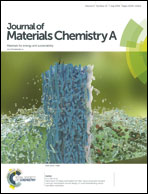Dual-grating-induced light harvesting enhancement in organic solar cells†
Abstract
Despite the rapid development of organic solar cells (OSCs), light harvesting efficiency is limited by a compromise between light absorption and charge recombination loss due to the low carrier mobility of organic materials. To circumvent this block, a facile route is to implement the photonic structures into an ultrathin photoactive layer of OSCs to fully use the incident light. Herein, a simple yet cost-effective paradigm for light-trapping enhancement of OSCs is proposed by introducing the dual-grating patterns via a two-step soft nanoimprinting technology. The original grating templates are simply duplicated from a commercial CD or DVD disk, which can avoid the complicated mold fabrication process and allow the easy transfer of various two-dimensional grating patterns into OSCs. With an optimized dual-grating, a substantial increase in the photo-generated current of 11.6% is realized, yielding a power conversion efficiency of 9.92% for PTB7:PC71BM-based OSCs. The experimental and theoretical studies demonstrate that the light-trapping enhancement is attributed to broadband light scattering and the grating period longer than the absorption region can minimize the destructive interference. We anticipate that the proposed light manipulation scheme could help to achieve highly efficient OSCs of various material systems due to the ease of use and drastic improvement in efficiency.



 Please wait while we load your content...
Please wait while we load your content...